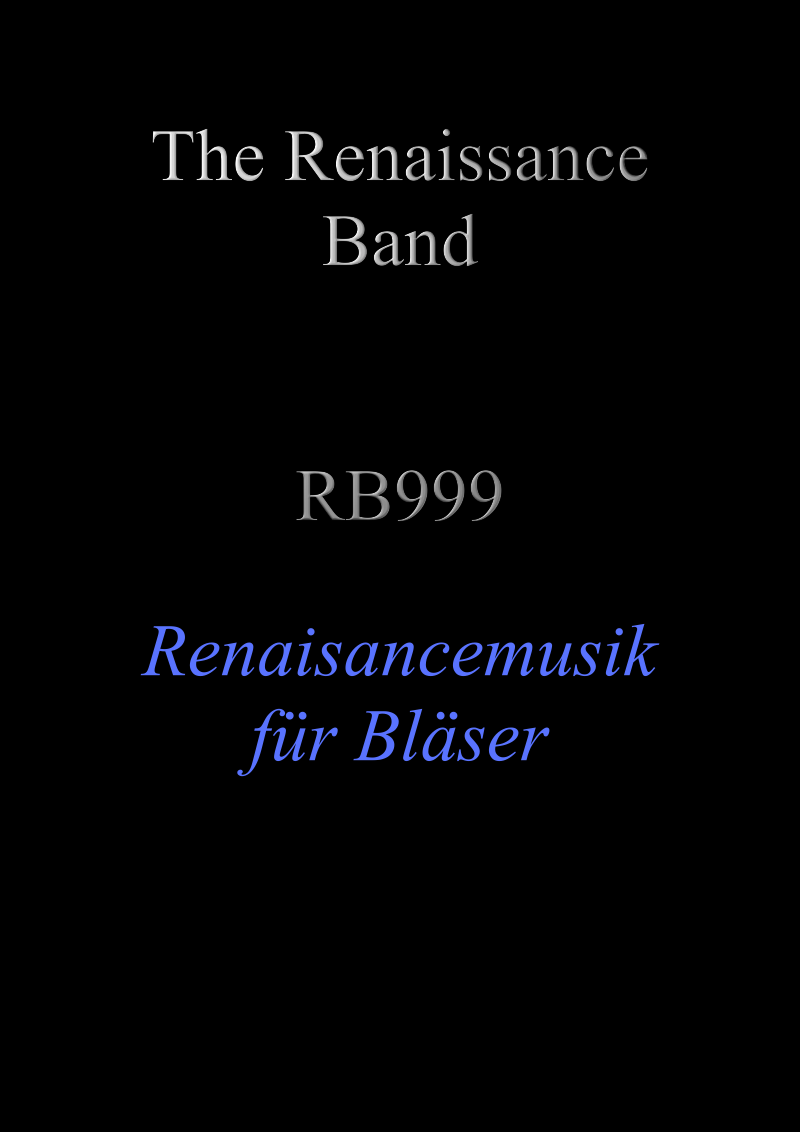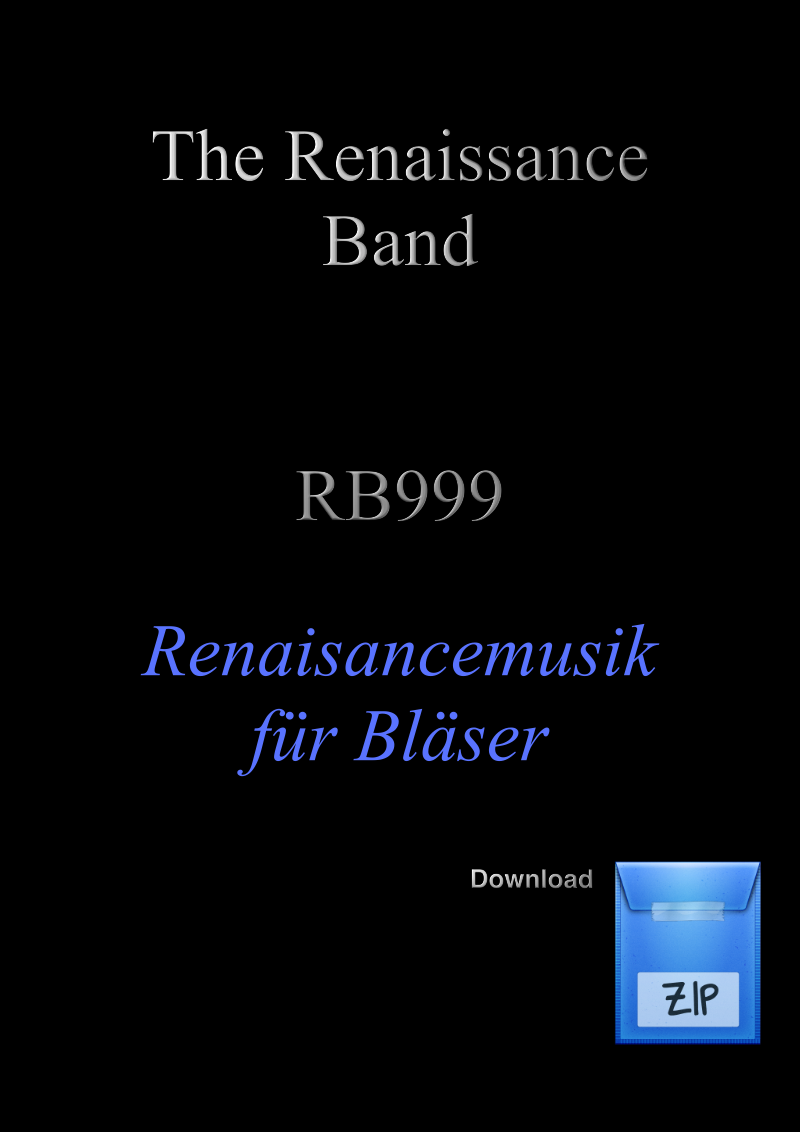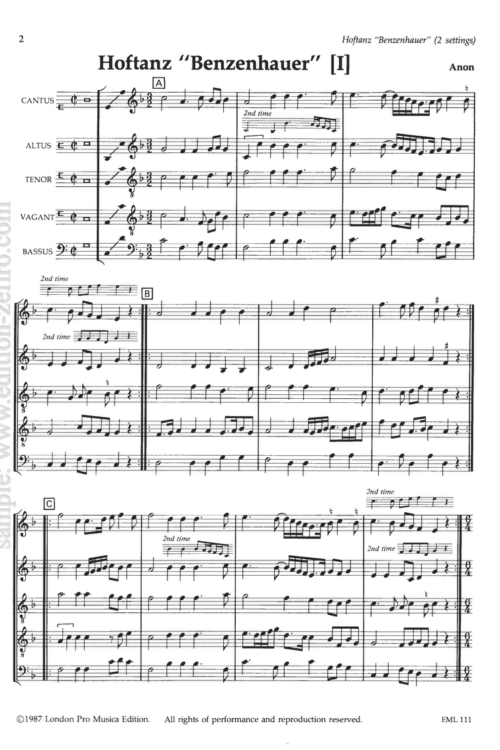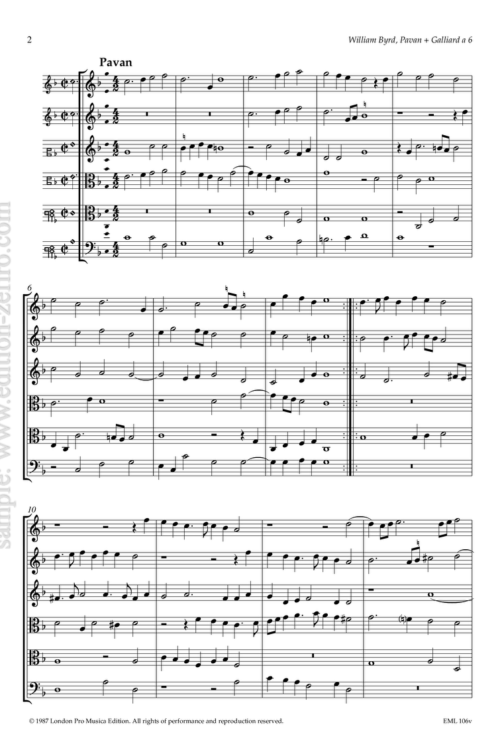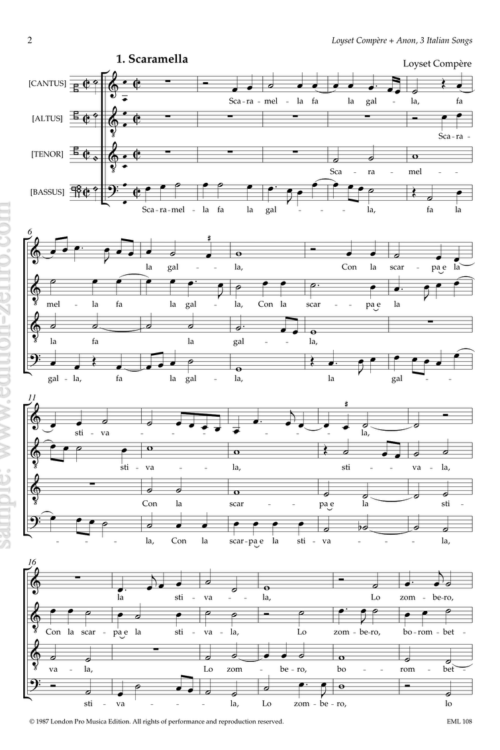Includes 5 volumes of the Copenhagen Wind Collection, and books of chansons, madrigals and dances.
- T’Andernaken
- 5 part (ATTBB) Print format: score + parts
Composer: Petrus Alamire flourished: 1500
Flemish: RenaissanceIncluding
- T’Andernaken
This fascinating setting of the Dutch popular tune was originally in four parts, with a fifth part added later. Alamire was a mysterious figure who, among things, was a spy, and a double agent to boot.
- 2 Madrigals
- 6 part (SSATTB) Print format: score + parts
Composer: Francesco Corteccia flourished: 1540
Italian: RenaissanceIncluding
- Guardane almo pastor
- Chi n’ ha tolt ayme
These 2 pieces are from the Florentine 1539 intermedii, which include a range of contrasting pieces by various composers.
- Kassel Pavan Collection
- 5 part (SSATB) Print format: playing score
Composer: Landgraf of Hessen flourished: 1610
German: RenaissanceMoritz Landgraf of Hessen, often know as Moritz der Gelehrte (Moritz the learned) was more than an aristocratic patron: he composed a large number of pieces, some of which are really rather good. Assuming that they were actually written by him (always questionable with royals) he was a good musician. - 4 Sonate a 5 Bombardi
- 5 part (SATTB) Print format: score + parts
Composer: Various flourished: unspecified
nationality unspecified: era unspecifiedThese unusual pieces for 5 bombardi were probably intended for performing at church festivals like Easter. They can of course be player on other wind instruments. - Copenhagen Collection Vol. I
- 6 part (SAATTB/SATTBB) Print format: score + parts
Composer: Various flourished: unspecified
nationality unspecified: era unspecifiedThe Copenhagen Wind Collection (MS 1872-3) was compiled for the royal wind band in Copenhagen. Consisting mostly of motets, it show what such a wind ensemble would paly. - Copenhagen Collection Vol. II
- 7 part (Multi) Print format: score + parts
Composer: Various flourished: unspecified
nationality unspecified: era unspecifiedThe Copenhagen Wind Collection (MS 1872-3) was compiled for the royal wind band in Copenhagen. Consisting mostly of motets, it show what such a wind ensemble would paly. - Copenhagen Collection Vol. III
- 8 part (Multi) Print format: score + parts
Composer: Various flourished: unspecified
nationality unspecified: era unspecifiedThe Copenhagen Wind Collection (MS 1872-3) was compiled for the royal wind band in Copenhagen. Consisting mostly of motets, it show what such a wind ensemble would paly. - Copenhagen Collection Vol. IV
- 5 part (SATTB) Print format: score + parts
Composer: Various flourished: unspecified
nationality unspecified: era unspecifiedThe Copenhagen Wind Collection (MS 1872-3) was compiled for the royal wind band in Copenhagen. Consisting mostly of motets, it show what such a wind ensemble would paly. - Alma redemptoris mater
- 6 part (SATTBB) Print format: score and parts
Composer: Ludwig Senfl flourished: 1520
German: RenaissanceThis magnificent setting of Alma Redemptoris mater is only found in the Copenhagen Wind Collection. - 7 Double Canons (score only)
- 4 part (SATB) Print format: playing score
Composer: Various flourished: unspecified
nationality unspecified: era unspecifiedIncluding
- He l’ort, villain jaloux
- Qui ne regrettoit le gentil Fevin
- Adieu mes amours
- Recordans de mia segnora
- La Spagna
Andrea Antico published a book of double canons in 1520. This is selection, with pieces by Mouton, Josquin and others. Complete edition in our RM9.
- La Spagna
- 5 part (ATTBB or SAATT) Print format: score + parts
Composer: Josquin des Pres flourished: 1500
French: RenaissanceThere is some doubt about the authenticity of his piece; some believe it was actually by Petrus Alamire, whose ‘T’Andernaken setting (RB1) is rather similar. But in any case it is written in a strongly instrumental style. - 12 Chansons
- 4 part (ATTB) Print format: playing score
Composer: Various flourished: unspecified
nationality unspecified: era unspecifiedIncluding
- Impossible est que je puisse vivre
- Las! Il Fauldra
- Le bon espoir
- Qui veult entrer en grace
- Petit coeur franc et gratieux
- De trise cueur
- Pius ne me chault
- Ce fut amour
- Quant je congneu en ma pensee
- Mon coeur gist tousjours
- Vion viette
These simple chansons have been transposed down a 4th to enable them to be played on wind instruments such as crumhorns.
- Dances – Praetorius and Haussman
- 5 part (SATTB) Print format: playing score
Composer: Michael Praetorius flourished: 1610
German: RenaissanceThese dances by Praetorius and Haussmann have been selected because their ranges are quite small, so will work on any wind instruments. - Madrigals and Villanelle
- 3 part (SAT) Print format: playing score
Composer: Various flourished: unspecified
nationality unspecified: era unspecifiedIncluding
-
- Altro non e’l mio amor
- A la mia grave pen’
- II nostro gran dolore
- Lieti felici spirit
- Menando gli anni
- Tristo che gionge
</ol
These simple madrigals and villanelle have been chosed to fit on wind instruments such as crumhorns.
-
- German song,,,s of the early sixteenth century
- 4 part (ATTB) Print format: playing score
Composer: Various flourished: unspecified
nationality unspecified: era unspecifiedIncluding
- Die vollen Bruedren
- Der Hundt
- Cupido hat im jetzt erdacht
- Fur all ich kron
- Ich schrei und rief
- Mein Gluck get auf der Setien aus
- Zu Regenspurg
- Wohlauff, gut G’sell, von hinnen
- Die Brinlein die da fliessen
- Zu Lob so will ich Singen
- Nichts werders ist
- Der Wnter Kalt
- Mir ist ein schons brauns Maidelein
- Es spricht der unweisen Mund wol
- Verleih uns Frieden gnadiglich
- Mein’n Fleiss und Mueh
- Es wolt ein Fraw zum Weine gahn
- Nun ist es doch kein Reuter
- An dich muss stets gedencken ich
These German songs have been transposed down a fourth to enable them to be played on wind instruments such as crumhorns.
- 2 Chansons
- 6 part (SSATTB or SATTTB) Print format: score + parts
Composer: Pierre Moulu flourished: 1520
French: RenaissanceIncluding
- En despit des faux
- La rousee du moy de mai
Little is known of Pierre Moulu, except that he worked in the Royal Chapel in Paris, and in Meaux.
He was known mostly for his sacred music and was a fine contrapuntalist.


